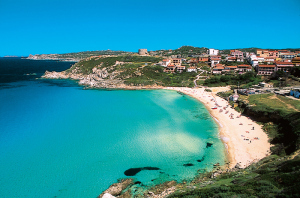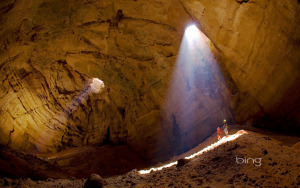Kellyann Zuzulo's Blog, page 11
November 2, 2012
A Story for The Day of the Dead
I wrote a short story a few years ago about the spirits that are active on The Day of the Dead, which is today. I’m running two excerpts from the story. Fernando runs a tour boat out of Miami’s Biscayne Bay. He lives in a high-rise there with his wife, Doris, who’s a self-centered bully. She tricks Fernando into smuggling a load of Cubans into Florida, under the guise that one of them is her cousin Ana, who’s in her seventh month of a high-risk pregnancy. At this point in the story, Fernando realizes that Doris had negotiated with the corrupt Tony to swindle the people on the boat of all their money and to use Fernando to do it. Despite his rancor, he is determined to bring the people on board his boat safely into harbor in Miami. Suddenly, a storm blows in…
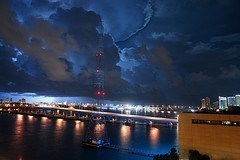
Storm over Biscayne Bay.
THE BALANCE OF POWER
Fernando watched Jaime lower the front of his body over the side to reach the anchor. Suddenly, he arched his back so that his arms flailed up and away from the side of the boat and his legs slipped forward, nearly pitching him headlong into the sea. “Madre, mío,” he screamed.
Fernando ran forward to grab Jaime’s feet. He pulled the boy back into the boat by the waist of his pants. “What is it, boy?”
“Hay, una mujer!” Hay, una mujer en el mar!” he yelled, pointing over the side.
“A woman in the sea?” Fernando peered over the side and felt a spasm of fear cross his chest that he might see a pale figure face down in the water. He saw only dark waves. “Was she floating?”
“No, no, she was alive. She jumped up to me and reached out her hand from the water. She called my name.” The boy began to sob.
Jaime’s crying woke Tony, who growled, “What’s going on?”
“Jaime thinks he saw something in the water,” Fernando answered.
Tony glanced over the side of the boat. “There’s nothing there.”
Jaime was crying and reciting in Spanish, “A woman, a woman was there.”
“It’s okay, kid,” Tony said. “Hey, now, don’t let your friends hear you. You were still half asleep when you reached into the big scary ocean.”
Tony turned to Fernando, “How much longer?”
“It’s taking longer that I thought because of the excess weight,” Fernando replied. “We still have a couple of hours.”
“Damn, it’ll be daylight.” Tony lit a cigarette, took a drag, and threw it into the ocean.
“And that’s if we’re lucky,” Fernando added, heading back to the wheel. “I don’t like the feel of this wind. It’s much brisker in the last half hour. And the waves are kicking up.”
Tony stood with his feet wide apart to balance himself against the swaying of the boat. “Hey, don’t go soft on me now. Just drive this baby home. A little rough water is to be expected.”
Jaime had returned to his seat on the bench and sat curled up, hugging his knees. He wiped at the tears on his face. Some of the other passengers had begun to awaken, whispering to each other in urgent tones. Fernando looked up at the stars. A dark shroud was stretched across the sky, blocking any glimmer. The wind began to play music upon his ears. It whistled and sighed, shifting tone with the angle of his head. Fernando imagined he could make out strange words on the air. The wind swirled around him, rushing like the chant of a mystical language. Waves crashed against the stern, creating tall fountains that splashed sea water onto the passengers sitting at the sides of the boat. They moved quickly to the floor of the boat.
“Jesus, this is blowing up quickly.” Tony zipped his windbreaker up to his neck.
“It’s a squall, Tony. That’s what they do.” Fernando gripped the wheel to keep the boat on a straight course.
“I’m going back to calm them down,” Tony said. He grabbed the edges of the cabin as he moved to the back. The deck was wet with spray from the waves. The sole of Tony’s shoe slipped from under him and sent his left leg up into the air as his torso fell back to the deck. His head banged against the compartment that held the life jackets. Tony landed unconscious on the deck.
“Dios!” Jaime yelled. He jumped up and ran to Tony. Three men from the stern ran forward. Fernando struggled with the wheel. To let go would be to lose control of the boat. He called to Jaime, “Get the others to help you bring him in here, out of the water. There’s a first-aid kit in the cabinet.”
The men half carried, half dragged Tony into the cabin and lay him out on the padded bench.
“Jaime, check to see if his head is bleeding,” Fernando yelled over the wind. A scream from the stern pierced the heavy mist that now cloaked the boat. Fernando could barely see the figures huddled on the deck. The men looked at him, fear in their faces. No one moved.
“Aqui,” Fernando grabbed the arm of the largest man and pulled him to the wheel. “Hold this steady, just as it is,” Fernando shouted to him in Spanish. He pulled on a life jacket that hung next to the wheel and moved to the stern. He tripped against a woman who was crawling toward the cabin. Another followed her, on hands and knees, gripping the tail of the first woman’s shirt.
Fernando grabbed the woman’s shirt and leaned over, “Who screamed?” The wind howled and the clanging at the bow had begun again. The woman stayed down and pointed to the bow. They scampered into the safety of the cabin.
Fernando stood straight. He felt something brush against his cheek. Jerking his head to the left, he saw that the glimmers that earlier appeared to be stars had dropped level with the boat and were flickering in and out with the wind across the boat. He ducked his head involuntarily as one flashed toward his face. It whistled a low treble in his ear.
Another scream shrilled against the wind. Fernando stood among the remaining passengers. He turned to the sound. The wind and sea spray buffeted him. Most of the people crouched low against the starboard side of the boat. One man stood and was trying to move quickly from the port side. Fernando screamed into the wind, “What’s wrong?”
The man struggled to move forward. The boat pitched him back against the railing. Fernando reached for his arm, but was knocked to the deck. He heard the man yelling, “Mujeres! Hay unas mujeres allá! They call to me!” And seeming to leap forward, the man disappeared over the side. Fernando threw himself against the railing and held fast while he gaped horrified into the dark churning water. He could not see the man. He rushed, trembling, to the compartment with the life preservers, grabbed one and stumbled back to the railing.
“Hola! Hola! Can you hear me?” Fernando called frantically to the water. He glimpsed a pale arm rising from the water at the rear of the boat. He tossed the preserver into the water. It jostled uselessly on the surface. The pale figure leapt up next to the preserver, splashing water into Fernando’s face. The visage of a woman stared back at him for a brief instant. He heard a whisper on the wind, “Nando.”
Fernando fell back from the railing, breathing heavily. The air was alive with sea spray and murmurs. Several of the passengers were whimpering or crying. He heard the hushed cadences of The Lord’s Prayer being recited. The silver sparks in the air fluttered about the boat, almost playfully, rising and falling on the gusts of wind. Fernando covered his head. The prayers of his mother pushed forward in his memory. His own lips moved in silent intonation. “Padre nuestro, que estas en el cielo, sanctification sea tu nombre…”
Fernando’s eyes strained into the darkness. A silver flash that rushed by his shoulder glistened with wings; the small figure of a translucent, fluttering, almost human, being. Fernando fell back to the deck. He struggled to control his fear. He reasoned soundlessly with himself; this was just a storm, made supernatural by the superstition of his culture. But he also knew, as a fisherman, that there was power in the wind and there was little resistance one could offer in the face of its fury.
A woman yelled out, “Aiyeee! Jimaniños!”
The wailing voices of several other people joined the cacophony. Fernando crawled back to the cabin. Tony remained unconscious. Fernando took hold of the wheel and slowed the engine. The clanging at the bow had now reduced to a slow tolling. The men’s faces were drawn and strained with unspoken fear. One man whispered to his companion, “Jimaniños.”
Fernando glanced sharply at the man. Jimaniños were the ancestors of Central American superstition. He did not accept them in his world. But the knowledge of what they were gripped tightly at his chest. Jimaniños were ‘little children.’ Little children, winged and tiny, who turned the Wheel of the Year. Elements of the air, the ‘little children’ were said to be the souls of human children, mischievous spirits who danced on the wind throughout the year but who celebrated most ferociously on the Day of the Dead in November. This was only April, but it was also the cusp of a change in season. The dawning of spring brought new life for nature and heightened activity from the elements. Fernando’s mother would have explained to him that the elements of a storm, of the air itself, were carried on the wings of these tiny fonts of energy.
Fernando’s mind flashed to the image of a woman in the water; an aquatic temptress who had called him to the sea. At least two other men had seen her, and one of them was now lost. Who was she? This mistress of the sea had shown fury in her beauty and vengeance in her whisper. The spirit of the ocean was alive this night.
Fernando tried to concentrate on the position of the bow. The wind was subsiding. He wiped the salt water from his eyes. He couldn’t be sure of what he had seen. The fear and the wind and the night had united them all in a frantic hysteria. But a man had fallen overboard. Fernando turned the boat in a circle where the man had gone over. As the waves rolled to a slow rhythm, the first hazy glow of sunrise illuminated the water. The orange preserver floated impotently. There was no body.
Fernando knew that they would never file a report with the Coast Guard. This trip was an illegal excursion; it didn’t technically exist. By forfeiting society’s power out here, they all had placed their fate on the wind. And fate had exacted a fee.
Tony awoke from his stupor with a headache and a slap for Jaime when he tried to recount his tale in a frantic rush. “Shut up, will you. It was a storm. You Cubanos and your superstition. I don’t want to hear it.” He rubbed a lump on the crown of his head.
“A man went overboard. He.….jumped in,” Fernando said.
“Yeah, that’s too bad. But these aren’t a seafaring bunch and it sounds like they went berserk when the wind picked up. At least he paid.”
Fernando stared fury into the man’s eyes.
“I’ll get word to his family,” said Tony with a wink and turned away.
Fernando knew there was nothing he could do without incriminating himself. He drove the boat in silence to a small harbor on Key West.
….SEVEN MONTHS LATER
Fernando has been plagued by images of the night the storm swept his passengers overboard. Although he resents his wife for her bullying, she is the one who decides to leave him. It is November 2nd, El Dia de Los Muertos, the Day of the Dead. She is packing her bag in their high-rise apartment overlooking Biscayne Bay and waiting for Tony to pick her up.
Fernando stepped out onto the balcony of his condominium 17 stories high in the Miami sky. The clanging somewhere on the marina became more insistent. Blackened storm clouds were building to a cone in the south. Fernando watched in fascination as the sky swept up a whirlwind of clouds from all directions. Far below him, cars zipped along the three causeways that connected Miami to Miami Beach. Gusts of wind tousled the surface of Biscayne Bay. Boats heaved and fell in their moorings.
Fernando glanced one last time at the water below. His own boat was there in the marina, tied for the weekend. He would not sail until he heard that the ill-conceived trip he had chosen not to captain was aborted, captured, or missing. Each possibility held great anxiety for him. He knew now what he and Doris had defied. They had presumed a crossing on the ocean for their own gain with no acknowledgement of the ocean itself, of the wind that was needed to bring them safely back. They had trespassed against the invisible divider that kept their world from the unseen one. Doris would never understand that; she was too much in the world, too anxious to profit from it. And Fernando had let it happen. He would never do it again, even if it meant losing his wife.
Fernando stepped through the sliding glass doors from the balcony into the apartment. He heard the clip-clop of Doris’ sandals on the kitchen floor. The tender feelings Fernando had felt toward his wife faded in the seven months since he made the trip to Cuba. He had drawn inward, seeking repose and forgiveness for his neglect of the ways his mother had taught him.
The growing cloud cover in the sky dimmed the light in the living room. The air inside the apartment seemed gray and misty. Although the days remained warm, the late fall sky darkened early in the evening. Today was November 2nd: It was El Dia de Muerte, the Day of the Dead. Fernando switched on the brass floor lamp. A dark yellow cone of light fell in a circle on the blue and red hook rug.
Doris stamped into the living room and went to the phone. She dialed the airline to confirm the departure of her flight and waited on hold, tapping her fingers on the veneer of the cream-colored end table. The trip had been planned for a clear sky. The sea charts and the forecasts had not predicted stormy weather.
Fernando walked to the window. The sky was cobalt blue. Great tufts of angry gray clouds rushed across it. The wind raised three-foot waves on the surface of the bay below. Somewhere, a loose yardarm on a sailboat clanged incessantly against the mast. That same sound had portended doom the night seven months ago when Fernando did his wife’s bidding and encountered the specter of fate.
Doris slammed down the phone. “Delayed. No planes are leaving. I have to wait until this friggin’ storm passes.” She paced around the living room, drawing a newly lit cigarette to her lips. “I’ll be late getting to Key West.”
“There may not be a boat arriving there anyway,” Fernando said without looking at her. “There’s a storm in the Caribbean tonight.”
“Who asked you?” Doris nearly shrieked.
Some tether snapped in Fernando. His fists were clenched as he stepped toward her. “Do you even know what’s happening? You loaded a boat with people who are made stupid by their desperation and you, stupid with your greed, know and care nothing for the waters that you float them in. You play with their lives. And you don’t even think about it.” Doris took a step backward. She lowered her cigarette to her side. For a moment, surprise lit upon her face. Then her lips curled and her face set again.
“Oh, bleeding heart. You have a corazon de sangria, no? Don’t tell me your woes. They don’t involve me anymore.”
“Don’t be so sure,” Fernando whispered.
“Are you threatening me?,” Doris yelled. Fernando didn’t answer. At that moment, a heavy gust of wind clattered against the pane. Doris walked to the window and looked out. She saw a gray cyclone of wind and clouds building and rotating, moving its way up the bay.
“My God,” she uttered. “It’s a hurricane.”
“Yes,” Fernando said, rooted to where he stood. He didn’t need to look out the window. He knew what he would see. “Today is El Dia de Muerte. It’s when they dance best of all.”
“What the hell are you talking about?” Doris kept her back to him, fixated by the momentum of the air along the bay.
“There are some things that can only be explained by our superstitions,” Fernando said. He sat in the wicker chair pushed against the wall. He mouthed a silent prayer. It was a prayer that came easily to him now. He had said it many times in the past seven months. He prayed at night and in the day when he rode the waves into the ocean. He prayed for the people on the boat somewhere off the coast of Cuba. Perhaps if they prayed, no man would be lost on this trip.
Doris had never seen a storm grow this way. Blasts of wind carried debris in its charcoal folds. She saw silver sparks at the perimeter of the cone. The cone pushed a swath through the water, knocking waves sidelong into both sides of the bay.
“It’s incredible,” she said, mesmerized. “Come, look at this.” Fernando stayed seated. Doris pressed her face against the glass to see the hurricane as it moved up from the mouth of the bay. Unblinking, she saw the sparks flash close to her building and then blow wildly toward the hurricane. A series of sparks crackled out of thin air and lit against the window. Doris was knocked back by the shock. She stepped forward. A curve of oily, wet smears colored the glass as if a sponge had been wiped along the outside. Sparks materialized again. This time, Doris saw tiny pudgy faces gleaming in at her, their tiny fists pounding briefly against the glass. With a scream, she fell back onto her behind, her arms stretched behind her. “No, que esta pasando? What the hell is it!”
Fernando’s lips formed the word. “Jimaniños.” He rose from the chair. A powerful crack and thunder split the window. A thousand splinters of glass fell to the floor and then rose in the spiral of the wind.
Doris screamed. A gray pelting mist swept into the apartment, whirled and then deserted. He watched unmoving as Doris was dragged by the force of the wind through the open window. Fernando was knocked back into the chair. His head banged against the wall and everything went black.
The sound of distant sirens and a vague pounding noise roused Fernando. He staggered from the chair. It seemed to be raining inside the apartment. The air was wet and misty. A damp breeze filled the room. The pounding was someone banging on the door.
“Is there anyone in there? Open up, if you hear us.” The door popped forward into the room and onto the floor. A group of firefighters in yellow rain gear burst into the room.
“Sir, sir, are you alright?” One of the men rushed toward Fernando.
Fernando stood dazed in front of the broken window. “My wife.”
“Where is your wife, sir? We have to evacuate the building.”
He pointed into the air outside. “She was taken there.”
The firefighter looked at his two colleagues who had followed him into the apartment. “Taken, sir?”
“The wind. She fell.”
“Okay, guys,” said the firefighter, “let’s take him down. He’s in shock. We’ll get a description later.”
Two of the firefighters gently took Fernando by the arms and moved him toward the door. The first firefighter spoke into his radio. “Seventeenth floor secured. Possible fatality.”
Fernando felt the warm air brush the back of his neck as he walked into the hallway. A pact fulfilled.
Best Wishes,
Kellyann
Read
THE GENIE IGNITES
on your ereader today.
Also available from Boroughs Publishing Group at these retailers.


November 1, 2012
Hurricane Sandy and The Day of the Dead
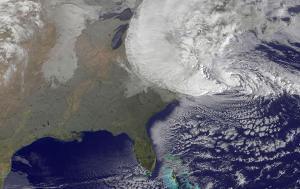
Hurricane Sandy closes in on the Mid-Atlantic states on October 29, 2012.
We’re recovering from Hurricane Sandy. Power went back on last night, after only 48 hours without electricity and heat. I say only because there are a lot of people who will be without power for much longer than that. And the temperatures are dropping. We live about an hour inland from where Sandy completely devastated the Jersey shore. The images of the destroyed coastline are heartrending. I grew up going to the Jersey shore every summer and continued to go with my own family. That geography has been irrevocably altered by nature. Memories have become history. While my family and I spent a good 18-hour cycle in the sump pump pit bailing out water that was overflowing into our basement, we’re grateful that the damage we experienced wasn’t worse.
I’ve always been awed– and a little frightened– by the raw force of nature. Sometimes we forget just how raw it can be because we have roofs over our heads, heat in our houses, storm doors and strong walls. But it’s important, I think, to remember that not everybody has shelter today, especially after a force like Sandy hits. And to reach out somehow and help. The Red Cross is one way to do that with a donation of money or time.
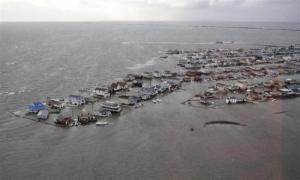
Nature can be more frightening than fiction. Here, the Atlantic Ocean submerges the Jersey shore.
Today, I had planned to post a scene from a short story I wrote several years ago called The Balance of Power. In the story, a hurricane hits Miami on November 1st, The Day of the Dead (Dia de los Muertos). Within the storm lurk elemental creatures who wreak specific havoc on the characters. Dia de los Muertos originated in South America as a celebration to remember family and friends who have died over the course of the year. This holiday parallels the Feasts of All Saints Day on November 1st and All Souls Day on November 2 in the Catholic Church. But in the rich and textured tradition of South American myth, there is also a belief that spirits cavort and frighten on these two days. Among these spirits are jimaniños, fairies of the wind who resemble pudgy children with wings and are responsible for turning the Wheel of the Year. I put jimaniños in my story because it was a way to lull the main character into a sense of a benign appeal in nature. He watches the wind whipping up on the other side of his window and thinks he is safe. Within the wind are these tiny figures who resemble children and he still thinks he is invulnerable. But jimaniños are as relentless as a hurricane.
We’re always trying to process and understand forces over which we have no power. Dia de los Muertos evolved as one way to do that. And to honor our dead. We create stories to deal with our fears or to explain things we don’t understand. Sometimes, though, there is no fiction that can rival nature itself.
I’ll post the scene tomorrow.
Best Wishes,
Kellyann
THE GENIE IGNITES, Book One in The Zubis Chronicles


October 29, 2012
Do These 9 Things to Live Longer
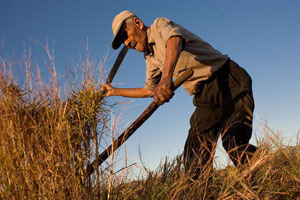
One of the secrets to long life is to keep moving,
as this man in Nicoya, Costa Rica does.
Everyone would like to add years to their life. And everyone has suggestions on how to do it. Since I study genies for my books, I’m especially intrigued by the concept of longevity. The life span of a jinni is estimated to be in the millenia. We’re lucky to get a century. So if you had a genie friend, there are some things you can do, according to this study, to extend your days. I came across an article in the Day in Health column that explored a study by Dan Buettner, author of The Blue Zones: 9 Power Lessons for Living Longer from the People Who’ve Lived the Longest. Buettner analyzed the factors that contributed to the long lives of people in the communities of Nicoya, Costa Rica, Sardinia, Italy, and Loma Linda, California. These stalwarts live an average of 11 years longer than the typical American. Nine things that might give you an extra 11 years. Sounds like a fair trade to me.
9 Secrets of Longevity
As Buettner and his team studied the Blue Zones, they identified nine common traits shared by those communities where people live longer. He was surprised that it wasn’t only food and lifestyle, but also creating a most beneficial environment. Here’s a look at these longevity-boosting traits, known as the “Power of 9.:
Sardinia, Italy was another site studied for its inhabitants’ long lives.
I think I could live longer here…
Move naturally. “Do your own house and yard work, go up and down your stairs with your laundry, knead your own dough,” Buettner advises. “Incorporate more movement every hour.”
Know your purpose. “Take time to recognize your values, strengths, talents, passions and gifts,” Buettner says. Reflect, and work on yourself.
Down shift. Relieve chronic stress by finding time each day to nap, meditate or pray.
The 80% rule. Cut 20 percent of your daily calories with proven healthy practices: eat a big breakfast, dine with your family, and begin each meal by expressing appreciation.
Plant slant. Eat mostly plant-based foods, and small portions of meat no more than twice a week.
Wine at 5. Drinkers live longer than non-drinkers. This longevity tip had one exception: those in the Loma Linda Blue Zone were Seventh Day Adventists, who abstain from alcohol.
Family first. Living in a loving, thriving family can add up to six years to your life. Work on a positive, committed relationship and stay close to your aging parents and grandparents.
Belong. “Those with the most social connectedness tend to live longer,” Buettner says. Be part of a group of healthy-minded, supportive people.
Right tribe. Good friends have a positive effect on your longevity. Support them and adopt healthy behaviors together.Best Wishes for a Long Life,
Kellyann
Zubis lives thousands of years. Check out The Genie Ignites.


October 26, 2012
You Are Dr. Frankenstein: Bring Your Characters to Life
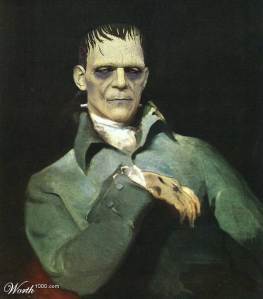
Give your Frankenstein’s monster some style.
With a vision, some madness, a computer, and electricity (or a strong battery), you too can be Dr. Frankenstein. As a writer, I am constantly searching for parts and pieces that will create a magnificent creature, eh, character. But once I stitch all the pieces together, I have only a one-dimensional lump. I then need to infuse that lump with emotion, expression, passion. I can do it. You can do it. *cue maniacal laughter* It is the power of the imagination.
Scan the images that you see every day.
Every day we hold images in our hands, literally. Androids, iPads, Kindles, and Notebooks. We live in such a visual society that images constantly bombard us. Is it hard to separate an image that originated in the mind from one that already exists. Maybe. But that’s okay. Writing is synthesizing what you imagine and what you see.
Once I wrote my first genie novel, I would assess actors and models as to who would make the best Zubis the jinni. That’s normal. Every author eagerly imagines that their novel may someday be a movie or show. As a matter of fact, I just came across images last week of Felix Baumgartner and thought, “He looks like he should live in Jinnistan.” I sense a character coming: “corded with muscle” “rugged” “confident fearlessness.” The beginning of a new creature, eh, character.
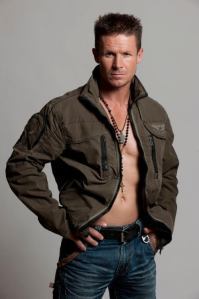
Baumgartner: Definite jinni material.
Create a checklist of characteristics.
I created Zubis because I had read a lot about genies and Middle Eastern myth. I had a sense of what he should look like. Dark hair: check. Broad shoulders: check. Tall: check. Scar: check. Intense expression: check. But he began to come to life (“Uhhhrrrr-uhhhhrrrr”) when I scanned the faces I saw around me, in media and on the street. Did I see Zubis as an actor playing a role on the SyFy channel before his features drifted from my consciousness onto the page? Maybe. And if it did, would that be a bad thing? Nathaniel Hawthorne probably saw people on the street, albeit garbed in muslin and flannel from collar to ankle, who made their way into his physical descriptions.
The people we see every day inform our characters. Just as interactions we have every day inform our narrative. A writer doesn’t write in a vacuum. We incorporate what we see and experience into our stories. We are purveyors of emotion and form. We are creators. *cue maniacal laughter*
Collect images, not body parts
Get the body, add the emotion.[Jason Momoa]
I would recommend that a writer working on a novel should clip and paste into a file those faces and figures that fit our characters. If you have an established, recurring protagonist, then keep track of how they react in various situations. Develop a character profile. And don’t be afraid to base those traits on real people. After all, our characters are real when they’re in our head. Make them real for your readers.Pulling these images from the ether is also a good exercise for a book trailer. Even if you never distribute it, a trailer develops your understanding of the world your characters live in. Connecting what is in your head with what can be realized is one more step in competent world building. Most people have Windows Movie Maker on their laptops (or a more-polished Apple program) or a similar program that can easily accommodate your own production. Think it. Make it. Bring it to life. *cue maniacal laughter*
And when I cobble my images together and add some modern technological wizardry, this is what I get:

Best Wishes,
Kellyann
Bring Zubis to life in your ereader.
On Kindle. On Nook.


October 23, 2012
A Meeting Place for the Jinn
Majlis al Jinn [©Mark Daffey Lonely Planet]
Genies like to hang out. Scholars, literature, and legend agree that the jinn are similar to humans in that they are a communal species. They eat, sleep, have families, and enjoy travel. Granted, their travel involves some sort of molecular transformation by which they whisk like, well, like a genie out of a bottle from one place to the other.In Oman, there is a cave that is known as The Meeting Place of the Jinn. Majlis al Jinn, also known as the Selma Plateau, bears the recent distinction of providing a BASE jumping site for Felix Baumgartner, that intrepid pioneer of free falls from space. Sounds like he has a lot in common with the jinn. The cave earned its name because Omanis in the region determined that the massive space, airy and craggy

Felix Baumgartner: kind of looks like a genie
and hard for humans to breach, was the perfect gathering spot for genies.
And, in fact, considered one of the largest underground caves in the world, Majlis al Jinn provides a beautiful illustration of what the land of Jinnistan might look like. Soaring rock faces, stratified rock in gradients of gold, brown, red, and pearl, a massive space of air that hovers around 17–18 °C or 65°F. Jinn are forged from flame and their own land is possibly a very warm place, but when they linger along the earth’s crust, they’re bound to lose some heat. And 65 is actually not that cool for a cave. Hmmm.
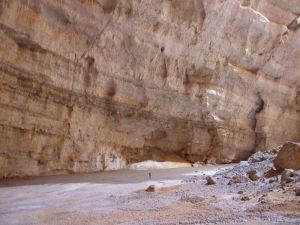
Walking on the floor of Majlis al Jinn
A single chamber with a domed ceiling about 410 feet high (that’s about 41 stories), Majlis al Jinn has only three entrances from the top. If there were any entrances to passages within the chamber, they have been blocked by sediment or debris. Or have they? Seems odd that the only way in is through the top. Usually, geologic formations pucker and pop, shift and settle over so much time. You’d think there would be catacombs, honeycombs, or perforations of some sort. Perhaps not. The jinn keep their houses nice and tight.
Currently, you need permission from the government to explore this cave. But there’s talk of Oman opening the cave to tourism. There’s a very informative article about Majlis al Jinn at the Desert Cave Project website, which includes an explanation for the jinn legend:
Wrath of the One-Eyed Genie
The geologist then explained that a woman named Selma supposedly lived here a long, long time ago and somehow or other got on the wrong side of a gigantic, one-eyed Jinn (Genie). Well, Selma decided to run for her life and as she zigzagged across this plateau, the Genie threw several thunderbolts at her. Luckily for Selma, the Genie’s depth perception was pretty awful, having only one eye and all, and three of those lightning bolts went astray, each one of them leaving a humongous scar in the earth.
Of course, only in modern times was it verified that the three holes are, in fact, skylights at the top of a single enormous chamber. On June 23, 1983, American geologist Don Davison Jr. rappelled to the floor of this cave and discovered to his amazement that he was standing in a single room 340 meters long by 228 wide with a 120 meter ceiling. As Davis later wrote (in AramcoWorld Magazine), “The Superdome in New Orleans—with a seating capacity of 97,365—could easily be contained within the cavern’s volume, with room for a 1600-car parking lot besides.”
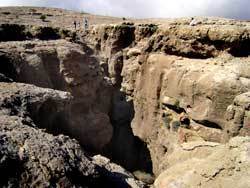
The entrance to the cave. Created by the jinn?
From the Sultanate of Oman’s tourist website:
Reaching the Cave opening requires strenuous physical effort, since you must traverse a distance of 1,300 metres to reach the cave opening through rugged mountain terrain. This trip takes about five hours. The only way to descend into the cave is by ropes. Geologists put the age of this cave (Majlis Al Jinn, or Salma Plateau as some like to call it owing to the area where it’s located) at fifty million years. The cave is considered a repository of natural life treasures.
Fifty million years is a long time. But the jinn live a long time, much longer than the life span of a human. Their creation is estimated to have occurred millions of years ago. It’s interesting to speculate that the jinn may have whipped by this cave at some point. I like to think so. In the third installment of The Zubis Chronicles, I’ll be including the spectacular cities, crags, and spires of Jinnistan as a setting. The world is already so full of awe-inspiring formations and locations, that it’s not hard to imagine a mystical world that may look like this.
Best Wishes,
Kellyann
Visit Jinnistan in THE GENIE IGNITES
ON KINDLE. ON NOOK.


October 22, 2012
Have A Seat, Then Get Up & Stretch

Heart-opening stretch.
I woke up this morning with a stiff neck. My go-to reason when my neck muscles are as tight as a rubber band in a 12-year-old’s slingshot is “I slept wrong.” Either I used too many pillows; pillow too flat; turns too turbulent. But, really, I’ve been sleeping for thousands of nights now, and you would think I’d know how not to “sleep wrong.” Besides, muscles this taut take more than one night’s “rest.” The reason more likely is “I wrote wrong.” Grammar, plot structure, and narrative aside, there is a wrong way and a right way to write.
I’ve been sitting at my desk for many days running. Creating new stories is usually very relaxing for me. Even the research phase sets me in a placid zone. But once I hit the rewrites or edits, the shoulders creep up into my neck, I slouch to get closer to the screen (as if there’s a dangling participle lurking somewhere on the screen), and I become affixed to the seat in an obsessive marathon of “getting it done.” WRONG.
Of course, as any published author will attest, the first step to being successful is to sit down and write. Jonathan Maberry, a multiple Bram Stoker award winning author and horror novelist said precisely that last week in an interview with Galleycat. I believe his exact words were “get your butt in a chair and write.” That’s excellent advice, and he offers more insight into the routine of a successful writer. However, what a lot of writing advice neglects to tell us writers after the “sit down” part is “get up and stretch.”
I know that I spend hours seated. I’ve actually reached a point where I need to remind myself to get up and stretch. When I sit for too long, my muscles rebel and constrict. Ultimately, I begin to associate sitting down to write with discomfort. Writing as a tortured exercise is a romantic notion but also a silly byproduct of simply sitting too long. Get out of your seat. You don’t have to go far. Stand next to your desk. Stretching stimulates the circulation. Blood flows more freely through the heart and brain and outward to the appendages. Muscles are massaged and aerated. Stiffness is dispelled. I would contend that limber muscles contribute to limber imagination. Try it.
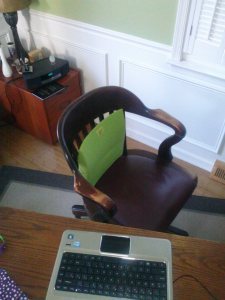
This is my desk chair. It’s empty because I’m stretching. Try it.
Here’s what every writer should do every 30 minutes:
Stand up at your desk.
Inhale, and reach into the air as high as you can. Get up on your toes. Grasp above your head for the success that is within reach. (There’s some positive visualization in this effort as well.)
Exhale and slowly windmill our arms down and back behind you. Push out your chest. This is the heart-opening yoga position that’s pictured. Writing comes from your heart. It will be supplemented by the information in your head. But your heart is your source. Open it.
Hands on hips, bend to one side and then the other. Stretch up from your waist and through your ribs. Breathe.
Exhale and touch your knees. Touching your toes is great if you can do it but, generally, is overrated. We’re writers, not gymnasts.
Dangle your arms. Relax.
Stand up, breathe in, smile. Have a seat and get back to work.
Repeat in 30 minutes.
I guarantee a more productive writing day.
Best Wishes,
Kellyann
Read THE GENIE IGNITES today.
On Kindle. On Nook.


October 19, 2012
Alex Cross vs. The Genie Ignites
What a coincidence that a new movie based on James Patterson’s Alex Cross character and my book trailer are released on the same day. Cross is going to have some tough competition when he goes up against Zubis from The Genie Ignites. I’ve read and enjoyed many of Patterson’s thrillers featuring Alex Cross as the protagonist. Whether Tyler Perry can pull off the rough, tough, and hard-to-bluff fictional detective remains to be seen. Last we saw Perry, he was wearing a blue-rinse wig as Madea. I enjoy Perry’s acting and the trailer sure does put you on edge (However, I don’t particularly enjoy a villain holding a sharp pruner that close to a woman’s bound fingers).
There are many similarities between the two heroes: Cross is devoted to his wife, determined to stop a killer, ruthless when he has to be. Zubis, too, is devoted to Bethany O’Brien, determined to stop more than one killer who threatens Bethany and, frankly, global security, and ruthless even when he doesn’t have to be. Just because he can. More similarities? Let’s see. Perry wears a dress as Madea. Zubis wore a skirt back in the day…when it was fashionable for men to wear skirts.
I contend that one may depict tension as well as romance, determination as well as sensitivity, exotic locales and fancy threads without all the shooting. Okay, so genies don’t require guns to get the job done (though there are scenes of humans coming at Zubis with guns; so you’ll still get some mayhem). But the panache with which Zubis dispatches his enemies just may tip the scales against Alex Cross. Why don’t you be the judge. Gratuitous or fortuitous? Practical or mystical? Gore or allure? Cross or Zubis?
Alex Cross starring Tyler Perry:
The Genie Ignites book trailer for your viewing pleasure:
Oh, and you can pick up The Genie Ignites for a mere $3.99. Get yourself some microwave popcorn, snuggle down on your couch, and you just saved yourself $30 minimum at the theater and uncomfortable theater seats.
(That’s what you call “shameless self-promotion.” More about that next week. I don’t think that shame should have anything to do with promoting a book.)
Until next time,
Best Wishes
Kellyann


October 16, 2012
What Does a Genie Look Like?

In The Genie Ignites, Zubis is described as looking like…well…this guy. Who’s to say he’s not a genie?
Look in the mirror if you want to get the general idea of what a genie looks like. Supposedly, they look very much like humans. No, I haven’t ever seen a jinni. Or have I? There was this one contractor who tossed those split rails around like they were toothpicks on a canapé tray. The jinn are renowned for their talent and capacity to build things. This fellow was constructing a fence. Large, rounded and efficient biceps flexed and contracted, flexed and contracted, flexed and contracted; muscle and flesh glistening with sweat in the heat of the noonday sun…. hmmm….but I digress. The point is that the form of a jinni may be similar to that of a human, according to oral tradition and historical narrative, such as the stories in the Arabian Nights. You just may not be able to see him or her.
Scholars who have studied the jinn refer to the Koran which states that the jinn are known as the hidden. That they can’t be seen by humans. That their substance is vaporous or ethereal.
Surely he (Shaitan) sees you, he and and his tribe,
from where you see them not. [7:27]
Sort of gives them an advantage, doesn’t it? And how convenient for those days when a genie just doesn’t have time to wash her hair. As often happens in the Arabian Nights, a jinni is able to assume the form of a human or to actually inhabit the body of a person or an animal, including snakes, scorpions, horses, camels, cattle, sheep, or birds. [from The Jinn by Mustafa Ashour: Dar Al Taqwa, London, 1989]
There are certainly stories in the Bible about demons inhabiting snakes and animals. In three books of the New Testament–Matthew, Mark, and Luke–there’s a story of Jesus driving demons into a herd of swine. The demons were bedeviling a couple of unfortunate humans, disrupting the local peace. Their subsequent forced dive from a cliff was probably deserved. I contend those two malcontents were probably genies. We just don’t call them that. But the Western description of demons clearly overlaps with the Eastern sensibility around the jinn. Genies have been “demonized” in Western culture, yet not all genies are bad. And, frankly, I bet they prefer a two-legged body to a four-legged, hoofed sow. Nobody enjoys eating from a trough.
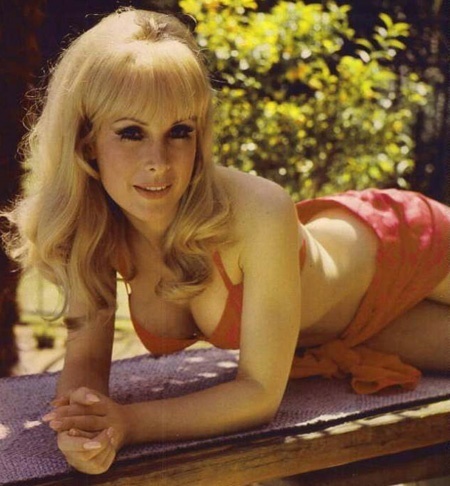
Barbara Eden played a genie on TV from 1965 to 1970. The physical resemblance to a real genie is uncanny.
Despite the now famous cartoon renderings of genies as blue and balloon-like, the West concedes a human body for the jinn.Voluptuous and attractive are possible genie physical attributes. Yes, that’s right. The genie in I Dream of Jeannie may be known to you and me as Barabara Eden, but she does a fine imitation of a genie. It just so happens that I own the entire DVD collection of the series. Really, it’s all in the name of research and not a juvenile appreciation for retro decor and pratfall humor. Okay, okay. I confess. At one point, I had a crush on Major Roger Healey. In my professional genie depiction opinion (and I’ve depicted many a genie in my books), the physical rendering is believable.
So, there’s your answer. If you’ve been up nights wondering what genies look like. Wonder no more. Genies look like us. Now, instead of chasing wisps of smoke and trying to catch a genie in a bottle, tune in to TV Land for a random episode of I Dream of Jeannie. Meanwhile, if you happen to see a real genie, don’t bother them with wishes. That’s a myth.
Best Wishes,
Kellyann
Meet some real genies in The Genie Ignites, from Boroughs Publishing Group.


October 12, 2012
Where You At?
Every once in a while, I use my blog space for a language pet peeve. I tolerate it as well as a corkscrew in the navel when people end some sentences with prepositions. Not in all cases. I’m not crazy. I just like to maintain a certain elegance in language.
Ending a sentence with a preposition is not incorrect. You can do it. If someone has a small, handheld contraption that you can’t identify, you wouldn’t point and say, “For what is that?” Go ahead, say, “What is that for?”
From The Grammar Bible, by Michael Strumpf and Auriel Douglas [Henry Holt and Company, 2004]:
Contrary to popular belief, it is not a mortal sin to end a sentence with a preposition, as long as the sentence sounds natural and its meaning is clear. . . . It is absolutely antiquated to forbid ending a sentence with a preposition.
Fair enough. Never let it be said, I advocated something antiquated (except for genies). But. I will maintain that sometimes it just sounds better not to end a sentence with a preposition. Case in point: Jennifer Hudson’s song, “Where you at?” It’s a really good song. She has an incredible voice. Would it be too much to ask her to re-record the song with “Where are you?” Same number of syllables. I should write a letter.

Meanwhile, there is another language peeve I have that is, in fact, incorrect. Here comes that corkscrew: When the subjective case pronoun I is used as the object of a preposition. I know, right? Horrifying. If the pronoun is the object of the preposition, it should be objective case me or her or him. Lady Gaga offers a great example of turning that corkscrew every time she sings ”There’s something about you and I.” Come on, Ga! It’s me. About you and me. Gaaaa!
Go ahead, listen for yourself. I’m going to listen again…well, because she has a great voice. And check out those skimpy though fabulous costume changes. If she and I did a video together, there may not be enough fabric for her and me. (See how I did that…)

Best Wishes,
Kellyann
Buy THE GENIE IGNITES with Zubis and me.


October 11, 2012
Social Netsharing Instead of Networking
http://www.thepopculturedivas.com/201...

